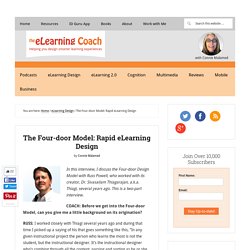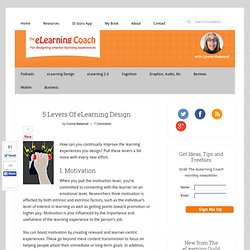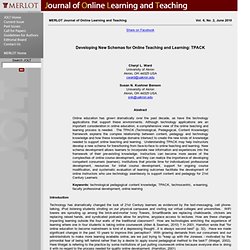

ARCS Model of Motivational Design (Keller. 9 Powerful Free Infographic Tools To Create Your Own Infographics - DATA VISUALIZATION. The Four-door Model: Rapid eLearning Design. SumoMe In this interview, I discuss the Four-door Design Model with Russ Powell, who worked with its creator, Dr.

Sivasailam Thiagarajan, a.k.a. Thiagi, several years ago. This is a two-part interview. COACH: Before we get into the Four-door Model, can you give me a little background on its origination? RUSS: I worked closely with Thiagi several years ago and during that time I picked up a saying of his that goes something like this, “In any given instructional project the person who learns the most is not the student, but the instructional designer.
COACH: What is the Four-door Model? COACH: Would you explain each of the components? 5 Levers Of eLearning Design. Sharebar How can you continually improve the learning experiences you design?

Pull these levers a bit more with every new effort. 1. Motivation When you pull the motivation lever, you’re committed to connecting with the learner on an emotional level. You can boost motivation by creating relevant and learner-centric experiences. 2. Brain dumps are out. Action-oriented implies the smart use of interactivity. Rather than creating bloated courses, the knowledge component of action-oriented eLearning is limited to what is required to improve performance at work. If you need help doing an analysis that focuses on what learners need to do, see When Your Content Resembles Spaghetti. 3. Pull the Strategies lever to design effective instructional strategies aligned with the goals of the learning experience. Instructional strategies consider the organization of content, creative treatment, approach to learning transfer, delivery mediums and opportunities for practice, feedback and assessment.
Scenario design in elearning: Two types of feedback. You’re at the county fair.

Your kids are off watching the pig race, and you’re starving. There are only two food carts nearby. One sells deep-fried pork skins from a pot of bubbling grease, and the other sells sushi from a styrofoam cooler. You decide to buy the sushi. As you hand over your money, a disembodied voice suddenly booms from the clouds above. You’ve just met The Omniscient One. “I know everything, and you have no brain” The Omniscient One (the OO to its friends) is a big fan of telling feedback, because it knows everything.
5 Great eLearning Boredom Busters. 5 Great eLearning Boredom Busters A common refrain heard by eLearning program developers is that using eLearning software is boring.

Often, learners find using many eLearning programs to be dull and passive activity, making them unlikely to retain the information the programs offer. As developers clearly want to create successful eLearning programs, they incorporate features intended to make the program more interactive and less dull. Colorful graphics, animations and video, quizzes, drag-and-drop content, and other features are used prominently to make the learner feel more engaged with the content. So why don't they work? Read carefully through this list of things to do to avoid boring eLearning courses that will ensure you to be a hit with your eLearning audience. Boredom Buster #1: An eLearning course is not a book report. Many eLearning programs make the mistake of focusing primarily on their content. Revising Bloated Prose. Over 40 Rapid E-Learning Posts with Free PowerPoint Templates & E-Learning Assets. JOLT - Journal of Online Learning and Teaching. Introduction Technology has dramatically changed the look of 21st Century learners as evidenced by the text-messaging, cell phone-talking, iPod listening students strolling on our physical campuses and visiting our virtual colleges and universities.

WiFi towers are sprouting up among the brick-and-mortar Ivory Towers, SmartBoards are replacing chalkboards, clickers are replacing raised hands, and syndicated podcasts allow for anytime, anyplace access to lectures. How are these changes impacting learning outside the four walls of the traditional classroom? How are technologies enriching the experience of learning where one in four students is taking online coursework (Allen & Seaman, 2010) ? In 2001, Hamilton wrote that "for online education to become mainstream is kind of a depressing thought...it is always second best" (p. 32).
One noteworthy outcome of the survey is that faculty believe that online learning outcomes may be inferior to those for face-to-face instruction. UDL At A Glance. Instructional Design resources.